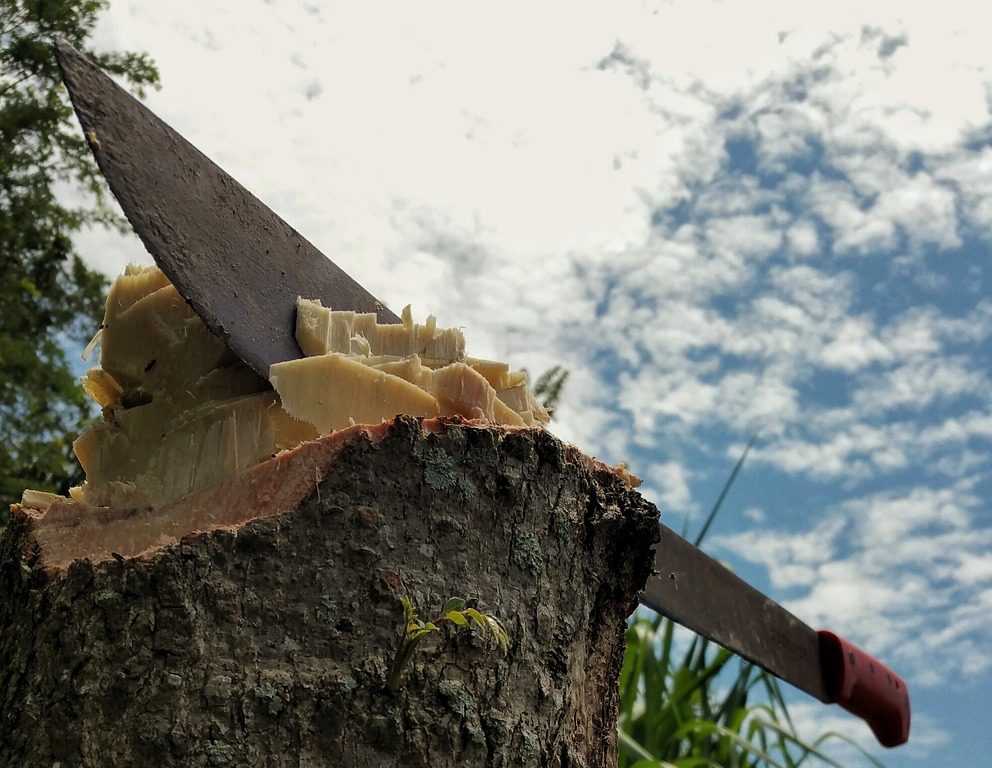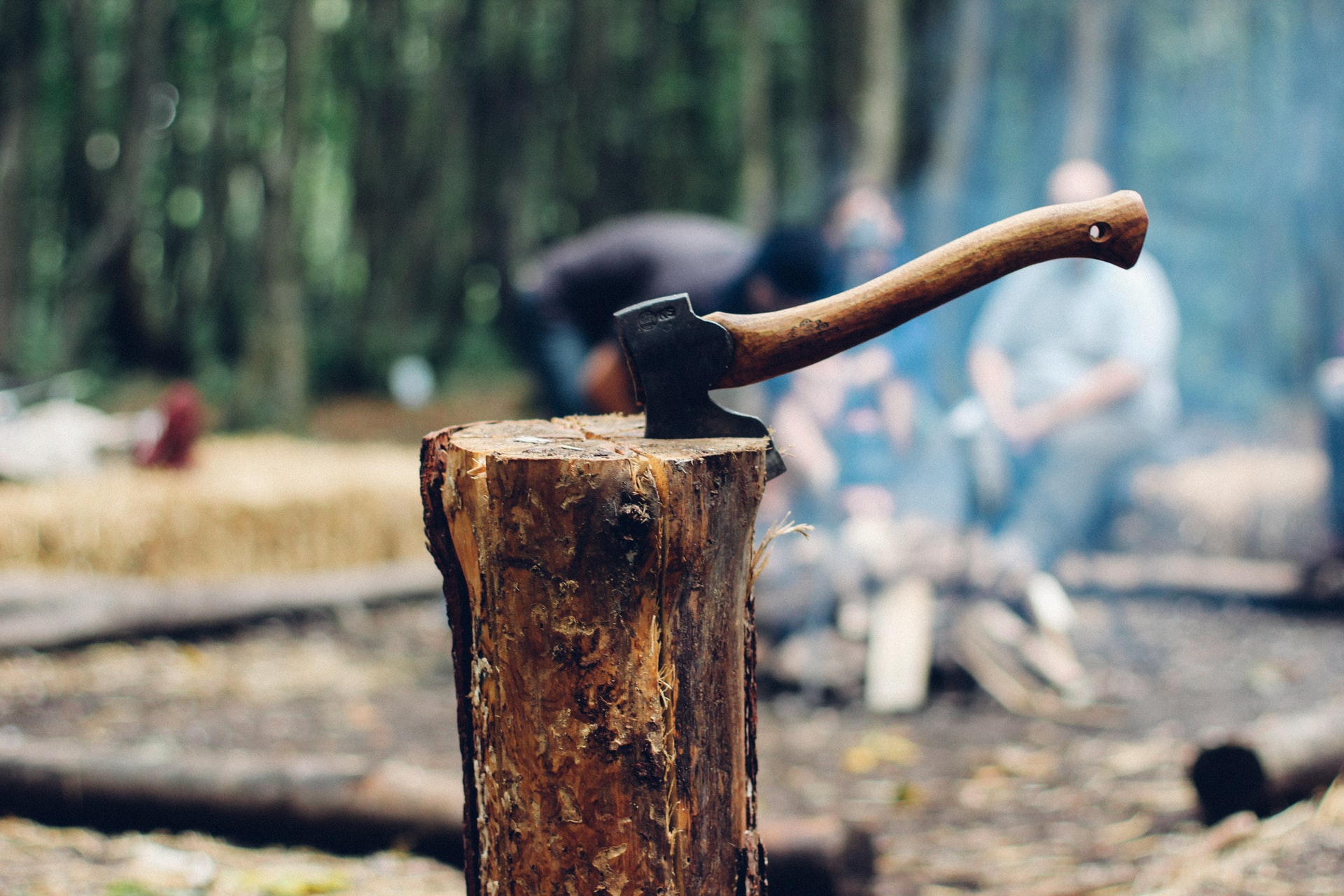Hatchets and machetes are two different tools with two different purposes. Both are single-edged bladed weapons, so they’re often used interchangeably. However, each item outperforms the other in certain aspects and environments.
This article will show you what tool to carry on your next trip. Hatchet vs machete; who’s the real winner? Let’s find out!
Outdoor Application
Hatchets are a single-handed striking tool used to cut, split, and hew wood. They have a sharp blade on one side and a hammerhead on the other.
They’re not to be confused with axes; while visually similar, axes are larger, heavier, and sharper as they’re used to chop down hardwood and big trees.
Hatchets are rarely marketed for combat and self-defense purposes.
On the other hand, machetes are large, heavy knives with broad blades that are typically 12 to 18 inches long. They’re often used to cut through rainforest undergrowth, clear underbrush, and chop wood. In Latin American countries and various tropical and subtropical countries, machetes are used for everyday household tasks and agriculture.
Due to the tool’s long blade, machetes are used as offensive and defensive weaponry in many countries. Regardless, they’re not designed to be a fighting weapon because they lack thrust power.
For outdoorsmen and women, machetes are great tools to fend off venomous snakes and angry animals.
Material
Depending on the intended application, the head of the hatchet is either made from low or high carbon steel. The halt, AKA the hatchet’s elongated handed, is traditionally made from hickory or ash. Hatchets with artificial composite handles are common but not as well-loved. A hatchet’s halt is typically around 18 inches in length.

Machetes likewise have blades made from carbon or high carbon steel. They’re thicker than an average knife but relatively thin compared to the head of an ax. Machetes have short handles made from wood, ivory, or plastic.
Chopping Power
Hatchets and machetes both have sharp blades on one side, allowing them to efficiently perform small tasks such as chopping, carving, and even dressing game.
Regardless, machetes are more intended for light to moderate chopping and/or hacking, while hatchets are more suited for heavy chopping due to their short but thick head.
If you’re planning to chop and split medium to large wood, hatchets are best suited for the task. Their weight, combined with their wedge-like bulky head, gives users the ability to chop through the wood with short, powerful strokes. They’re also ideal for splitting firewood.
Clearing Trails and Vegetations
Most outdoorsmen prefer machetes when it comes to clearing paths and blazing new trails. They’re also what most would go with for cleaning bush, cutting vines, and taking down small stems quickly and efficiently.
Machetes have a more extended reach, and they’re lighter than an average hatchet, therefore allowing wielders to deliver more swings without running out of breath.
Although hatchets yield more powerful strokes, they take a considerable amount of energy to use in prolonged periods. Furthermore, a hatchet’s short head makes it more or less unsuitable for clearing incredibly dense forest foliage.
Self-Defense
Hatchets and machetes make for decent melee weapons. The best and most obvious weapon choice is machetes due to their sharp, steady, and relatively lightweight blade. Plus, most machetes have a serrated back-edge, which can potentially produce a messy and fatal wound. They also allow for faster and more accurate swings and dabs.
In many tropical countries, machetes are the weapon of choice due to their availability. Machetes were said to be used in the 1994 Rwandan genocide and Cuban independence wars that occurred from 1868 to 1898.
Fictitious slasher movies, such as Friday the 13th and Downtown Defenders, used machetes as their primary weapons. This may have further increased their popularity in terms of self-defense weapons.
Hatchets make for decent makeshift weapons but only if nothing else is available. They’re too short to injure in combat effectively and too heavy to wield for prolonged periods. Hatchet-throwing is a useful self-defense maneuver, but accuracy is quite literally hit or miss.
Machetes can be used in a do or die situation against harmful medium to large animals such as wild boars, bears, and crocodiles. For small animals such as snakes, hatchets work brilliantly.
Improvisational Use
Hatchets are great all-around tools that’ll help you with most outdoor and backyard projects. Not only can they be used to chop and cut small trees and wood, but you can also use them for hammering nails and stakes in the ground. Furthermore, their small size makes them easier to use and handle for precision work.
However, if you require a more balanced, nuanced tool, machetes are your best friends. They’re ideal for agricultural purposes that require delicate cutting, like cutting sugar canes and splitting coconuts. Many countries use machetes like cleavers to chop and cut animal meat into manageable pieces.
Machetes are likewise ideal for coppicing, carving, and incising wood. They work exceptionally well with cutting and shaping snow shelters and removing invasive plants growing in your backyard, too.
Safety
Hatchets and machetes must both be used with extreme care as they can be dangerous when not handled properly.
Hatchets are generally safer than machetes because they have relatively long halts and blades that can easily be covered. Regardless, hatchets are intended for one-handed use, meaning you have less control when swinging.
As much as possible, hatchets shouldn’t be used to cut thick vegetation and trails aggressively.
Machetes are often sharper than hatchets. They’re much larger, too. Therefore, if you’re using your machete to cut and clear vegetation, make sure no one’s directly behind you. If you’re chopping an object, avoid hacking perpendicularly. If possible, use gloves while using your machete to prevent slippage.
Final Thoughts
Hatchets and machetes are great outdoor survival tools. There’s no real winner between the two; hatchets excel at heavy-duty chopping, while machetes are better used for light-to-moderate trial and vegetarian cleaning. The choice depends on the application and the environment you’re going to use the tool in.

